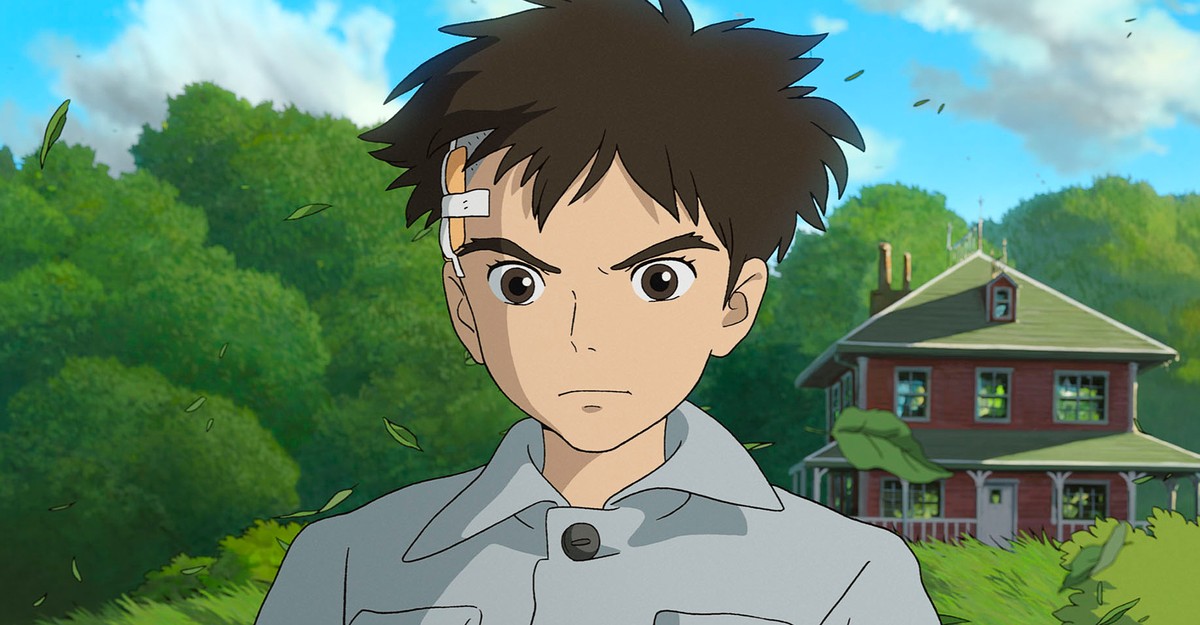Once, in a windowless conference room, I got into an argument with a minor Japanese-government official about Hayao Miyazaki. This was in 2017, three years after the director had announced his latest retirement from filmmaking. His final project was supposed to be 2013’s The Wind Rises, a World War II movie about a man who loves building airplanes but struggles to accept the destruction they bring. The official was glowering, talking into his coffee cup about how Miyazaki, an avowed pacifist, should’ve stuck to fantasy and stayed out of politics; he found the film to be a naive affront to the complexities that made war, in his view, a necessity. I contended that every Miyazaki movie contains some sort of societal critique, whether about environmental collapse, the ills of industrialism, or the cyclical nature of conflict. But the bureaucrat wouldn’t listen.
I’ve been thinking of this encounter since Miyazaki’s return to directing, with The Boy and the Heron, which is nominated for Best Animated Feature at this year’s Oscars. What must that official think of this movie, which deploys fantasy to present a powerful anti-war stance? A sprawling journey through a magical world, The Boy and the Heron features many of Miyazaki’s classic character types and plot devices. But where other directors might turn to overt, didactic arguments to make their point, Miyazaki uses a more accessible, intuitive dream logic. By inviting viewers into his story at the emotional level, he asks us to inhabit the perspective of his protagonist: a boy dealing with the destruction of his city and his mother’s death. The movie doesn’t pontificate that war is evil so much as it illustrates how war can destroy that most precious of things—the innocence of a child’s soul.
Miyazaki’s films tend to follow a similar arc: A child’s life is disrupted, something supernatural beckons, and the young hero navigates a bizarre new world, emerging in the end with a kernel of self-knowledge. The Boy and the Heron’s protagonist, Mahito, moves to the countryside with his father after the firebombing of Tokyo. At his new home, he is hounded by an uncannily humanlike blue heron who tells him that his mother is actually alive and trapped in a mysterious tower. At first, the director seems to be preparing Mahito for a typical hero’s journey. But a twist destroys the illusion of familiarity. A woman resembling Mahito’s mother appears upon the boy’s entry into the tower and just as quickly disappears, revealed to be a cruel trick of the heron. With that, Mahito’s most obvious and compelling motivation for continuing vanishes, but circumstance forces him to go on anyway.
What follows is a near-plotless romp, as the boy embarks on a series of seemingly disconnected and nonsensical adventures through the tower’s disturbing netherworld. But Miyazaki links every step in the quest with reminders of how the war has broken Mahito. For example, we see repeated nightmarish flashbacks to the flames that engulfed his mother at the start of the film. In moments of tension—when giant pelicans are swooping to eat the souls of unborn children, or even before Mahito enters the tower and is simply trying to sleep in his new home—visions of fire invade from all sides, menacing and oppressive.
We witness signs of Mahito’s fracturing psyche elsewhere, too: in the tears that well up while he sleeps, and in his cold sternness toward his grotesquely cheerful father, who builds parts for military planes and has married his dead wife’s sister. After picking a fight with kids at his new school, Mahito externalizes his pain by taking a rock and bashing it into his own head. Near the end of the film, the wizard who is revealed as the architect of the tower world gives Mahito a chance to build his own—but Mahito points to his self-inflicted wound and says he cannot accept the offer, because of the malice inside of him. He suggests that he’d likely create a similarly poisoned world because of the toll that war has taken on him.
Miyazaki has engaged with war in his past films. Porco Rosso features a man-pig hero who famously quips that he’d rather be a pig than a fascist. In Princess Mononoke, the destruction of a forest incites an epic battle among animals, gods, and humans. The Boy and the Heron simply takes what has thus far been a thematic concern of the director’s and solidifies it into a clearer viewpoint. As other critics have noted, Miyazaki’s latest movie has the feel of an artist reflecting on—even interrogating—his career. Many scenes and images in The Boy and the Heron echo those from his earlier films, only this time they’re rendered in service of a story almost wholly about the profound ravages of war. Miyazaki shows us the sideways musings of a master in his twilight years, who is revising and reforming old landscapes to sharpened political purpose—while keeping empathy and emotion at the center of his work.
It’s an approach that makes me hope that government official sees this movie. Perhaps, after spending two hours wandering through the wreckage of a young boy’s mind, he’d be moved to a different conclusion than before about the necessity of bloodshed. Perhaps he’d leave the theater convinced, just as Miyazaki seems to be, that war brings only tragedy, and that it destroys the worlds of children.

